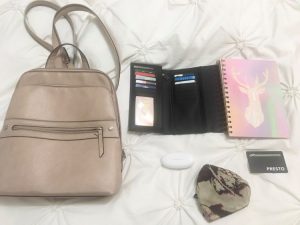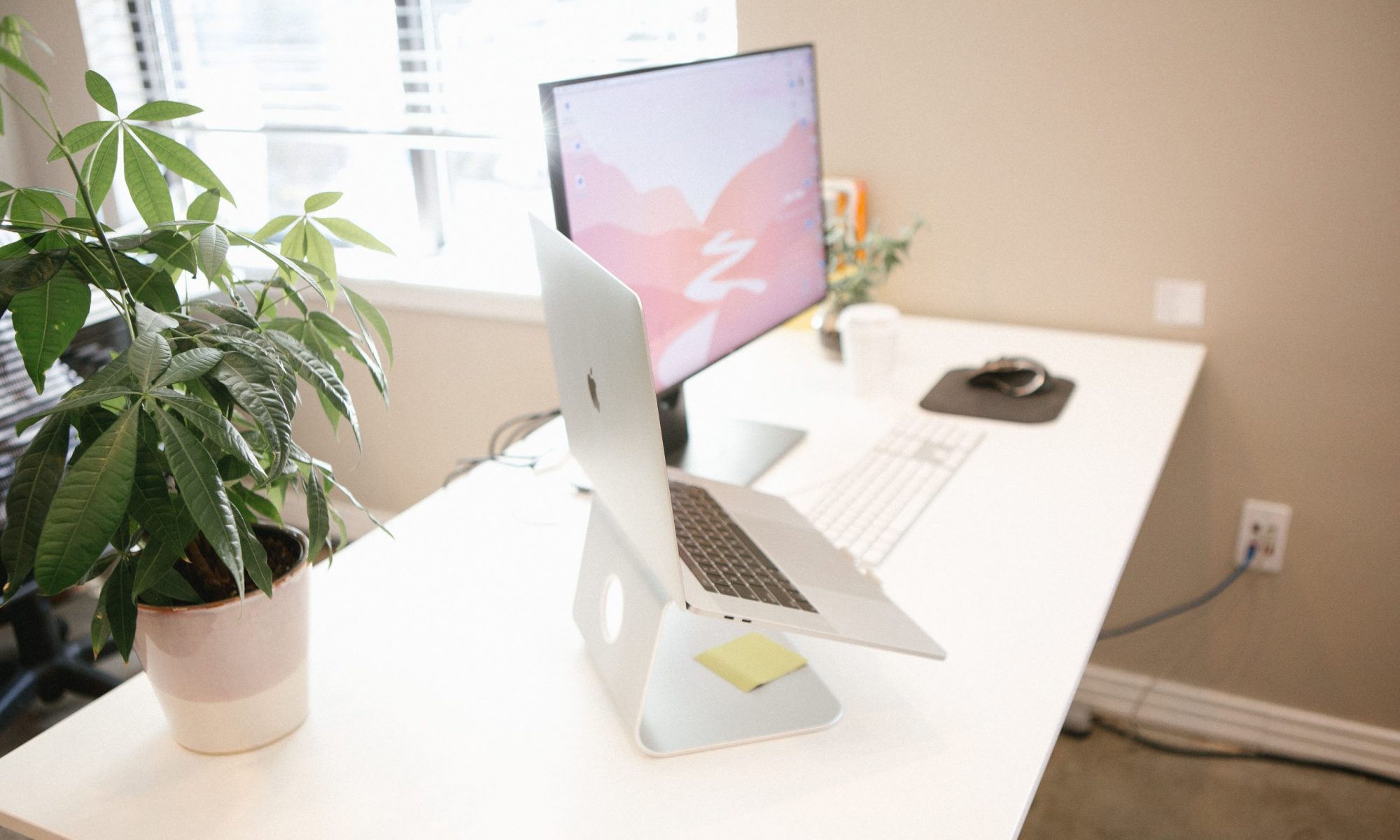Hello everyone, and welcome to my webspace! My name is Amy Jazienicki, and I work as a Learning Experience Designer (LXD) for a major accounting firm in Toronto. Due to the pandemic (and my firm’s flexibility), I am a fully remote employee. In addition to ETEC 540, I am also enrolled in ETEC 590 (ePortfolio) – after this semester, I will complete my MET journey!
In response to our first task “What’s in Your Bag?”, I’ve chosen to focus on the bag I regularly use. It is quite casual, and the items reflect my overall ‘minimalist’ sentiment: I only bring what I absolutely need for my daily walks when taking breaks from 100% remote work.

Bag: Designed with backpack-like straps, I purchased this bag last year so that I could more easily carry the items laid out in this photo while using space more economically. The bag has three ‘layers’ in which items can be stored and has a very uncomplicated design. It is intended to be used when out and about rather than for overnight stays with family and friends, for example. In my view, the bag’s design conveys both an aesthetic and practical presumption of ‘minimalism’.
Wallet: The black wallet contains a credit card, bank card, my health card, a Shoppers Optimum card, a library card, and other miscellaneous cards. Most of them show my name and possibly an identifying number and/or a bar code/chip that digitally communicates my information when I make a purchase or perform another task. Understanding how these cards generally function entails a sense of “technical literacy” that simply did not exist to the extent it does day even a few decades ago.
Notebook: This is the notebook I use for articulating short and long-term goals, documenting ideas for design/art/writing, and for brainstorming more generally. I have always found that the more ‘traditional’ method of physically writing out such ideas rather than typing them out permits greater spontaneity for me, as I can (re)write, erase/scratch out, draw, etc. Although I sometimes document ideas on my iPhone, such ideas are much more ‘structured’ and fleshed out as my Notes app doesn’t allow for as much flexibility in how I express these ideas; the iPhone is also smaller, so the notebook provides more ample space to ‘experiment’ with my ideas.
‘Nest’ for my Bluetooth Earphones: Though it might be a bit difficult to see in the photo, the white ‘nest’ containing my earphones has the brand name Taotronics printed at the top. Once I bring them to my ears though, I hear an automated voice that says “pairing”, “connected”, and other simple verbs or phrases that quickly inform me that they are functioning as they should be. This automated communication is designed to be unidirectional, informing the listener of the technology’s ‘status’ when connecting to a device.
Cloth Mask: Although there is no direct ‘text’ imprinted on my mask, there is a message embedded within it when I enter public places: I am taking proper precautions and ensuring compliance with both medical and legal requirements to help prevent the spread of COVID-19.
PRESTO Card: This is a card I use quite frequently, so I wanted to dedicate a sub-section to it. It is for Toronto residents to use for public transportation in and around the city, including buses, streetcars, and trains. The use of coins, paper tickets, etc. have gradually fallen out of favour for a more “digitized” experience across the different service lines of the city. To maximize the card’s benefits, it is essential to understand how to manage your settings and preferences through the website: for instance, you can set up an automatic renewal of funds directed from your bank account so that when the value drops below a given amount (of your choosing), you never need to be concerned about running out of funds while commuting. It also indirectly promotes a stronger sense of “financial literacy” as you can track how much you spend on your commutes, and even consider alternate routes to save money.
┏━━━━━━༻❁༺━━━━━━┓
I consider myself a fairly open book, so I feel as though the contents of my bag mirror the image I outwardly project: efficient and minimalist, yet still driven by simple design and aesthetics. Considering that I was a teenager 15 years ago and a child 25 years ago though, this bag would have been a backpack and much larger to accommodate textbooks, notebooks, writing utensils and other school supplies. The dominant “literacies” back then were still envisioned as the traditional ‘pencil-and-paper’, while the Internet was gradually growing in prominence. The prevailing methods of instruction in the classrooms reflected a more top-down, “teacher-as-authority” paradigm while using blackboards, whiteboards, and sometimes projectors as mainstay tools.
Even during my teens, “digital literacy” was still considered to be something novel and unique to youth primarily within the context of more leisurely activities: think of the MySpace generation when you could create profiles with customizable templates and HTML to present yourself to the world online before the advent of Facebook and other social media.
I imagine that an archeologist striving to better understand how the contents of this bag reflected the temporal period I live in would conclude that there is an intriguing intersection between ‘traditional’ literacies (e.g., writing in a notebook) and ‘digital’ literacies (e.g., PRESTO card). Although I am technically of the “digital age”, my belongings defy the notion that everything is always preferred in digital format: my “text technologies” reflect a hybridization of my choosing, opting for digital and print-based approaches in ever-changing personalized ways.

Hi Amy,
Thanks for sharing an interesting post! Your post resonated with me as you presented your assignment uniquely. The minimalist sentiment you value is preset as you explained your thoughts concisely. I enjoyed how you mentioned financial literacy, which I also mentioned in my post but you also included technical literacy which is nice. Mostly, I was able to connect with the last sentence of your post where you mention “text technologies reflect a hybridization of my choosing.”